Beginning of Orthodoxy in North America and first settlements of European Slavs in Canada
Orthodoxy on the North American continent began in 1794 when the first Russian Orthodox missionaries landed on the Kodiak Islands on the south coast of Alaska, bringing Christianity to the Aleut and Eskimo people. In 1867, Russia sold Alaska to the U.S., and soon the Russian Orthodox Church founded a parish in San Francisco, California where there was a small community.
While a Russian presence in the United States had existed for the greater part of the 19th century, Slavic settlement in Western Canada occurred with the opening of the West in the last decade of the century.
Western Canada was then the Northwest Territories or Rupert’s Island. In 1891, word of free land in Canada reached Eastern Europe, and soon after came the first wave of Slavs from Austro-Hungary, Russia and Poland, fleeing oppression, seeking freedom and free land – vilni zemli. Whole families of Galicians and Bukovinians came, filling steerage ships. The occupation of the head of the family in most cases was listed as farmer – a few were listed as labourers, carpenters, blacksmiths, etc. – but no priests at that time.
At Winnipeg, immigration officials directed smaller groups westward to suitable farm areas – many arrived at the end of the railroad in Strathcona (now part of South Edmonton). From here the land agent would direct them to open land – some went south to Rabbit Hill, but most others went northeast toward Star-Edna, and Victoria. Of course, the new settlers faced many hardships: no immediate shelter, limited sources of food, loneliness and a yearning for those things left behind in their homeland.
About Bishop Nicholas (Ziorov), 1891-98
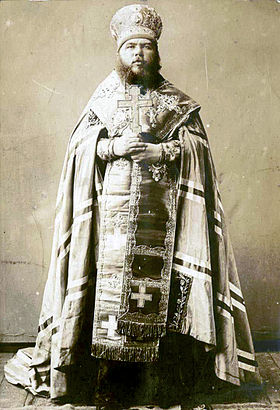 Bishop Nicholas (Ziorov) had been ordained to the Holy Episcopate on 29 September, 1891, and he was immediately assigned to serve as the Bishop of the Aleutian Islands and Alaska.
Bishop Nicholas (Ziorov) had been ordained to the Holy Episcopate on 29 September, 1891, and he was immediately assigned to serve as the Bishop of the Aleutian Islands and Alaska.
In 1897, Bishop Nicholas was the first bishop of the Russian Mission to pay a visit to some of the faithful who had settled in central Canada, around Winnipeg, Manitoba.
It was under Vladyka Nicholas’s leadership and blessing that the beginning of the return to the True Orthodox Christian Faith began.
By 1898, he had embraced many parishes in their return to the Orthodox Faith from the Unia. These included those in Chicago in Illinois; Cleveland in Ohio; Pittsburgh, Osceola Mills, Old Forge, Wilkes-Barre, Catasaqua, in Pennsylvania; Buffalo in New York; Ansonia and Bridgeport in Connecticut.
His pastoral work in North America was clearly not to be merely for the immigrants; but as well as that, it was for reaching anyone who desired to embrace the Orthodox Christian Faith, whoever that might be. The missionary work was and remained rooted in the Dominical command:
Go therefore and make disciples of all the nations, baptizing them in the Name of the Father and of the Son and of the Holy Spirit, teaching them to observe all things that I have commanded you; and lo, I am with you always, even to the end of the age (Matthew 28:19-20).
In 1898, Bishop Nicholas (Ziorov) was succeeded as Bishop of the Aleutian Islands and Alaska by Bishop Tikhon (Belavin).
About Theodore Nemirsky
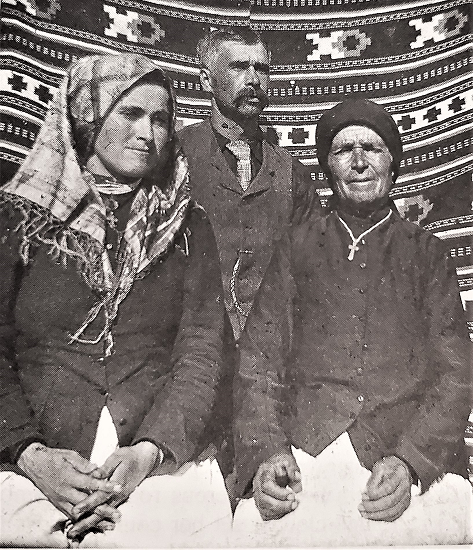
Katherine and Theodore Nemirsky, and Maria Magdalena Nemirsky
Interestingly enough, the two major and first centers of Orthodoxy in our Edmonton region were founded by the leadership of two Theodores – the name meaning “The Gift of God”, Theodore Furh at Rabbit Hill, and Theodore Nemirsky – at Edna-Star.
Let us first remember the early life of Theodore Nemirsky, who enjoyed great authority among fellow Galicians, and was one of the main initiators and benefactors of the movement.
Theodore Prokopievitch Nemirsky was born on 18 July, 1869, in Bilche Zolote, county of Borshchiv, Galicia (which is now in Ukraine) to Prokopiy Nemirsky (b. 1831, d. 1890) and Maria Magdalena Danylchuk (b. 1835, d. 1920). He had an elder brother, Konstantin (b. 1855, d. 1955).
Theodore was educated in Galicia, and he served in the Austrian army as was required at the time.
After his military service, Theodore Prokopievitch was prepared to marry a young woman of his own village, Katherine (Catherine) Semeonovna Marianicz.
Katherine was born on 10 January, 1878, in Zawale, Sniatyn, Galicia, Ukraine to Semeon (Sam) Marianicz and his wife Maria Wakaruk. Their village is now in the Ivano-Frankivsk Oblast of Ukraine.
Theodore, his wife and his family departed from their home in Bilche Zolote on 6 April 1896 (Great Friday).
Other families (including Theodore Fuhr) joined them there, and they took the train to Hamburg, Germany (on the River Elbe). There, on 12 April 1896, they boarded the S S Christiania. Although the first part of the voyage was peaceful, the second part was extremely stormy. The voyage lasted 18 days, and they landed at Québec on 30 April 1896.
As usual at the time, they travelled to the west by the Canadian Pacific Railway to Calgary, Northwest Territories (later the Province of Alberta), and then by the same railway on its branch north to Strathcona, across from Edmonton, on the south side of the North Saskatchewan River.
After his arrival in the area northeast of Edmonton, Theodore settled near Edna, Alberta (later known as Star, Alberta). With the help of friends, they constructed their first small home. In the summer, Theodore travelled south to work for the CPR [Canadian Pacific Railway] at Nanton and Fort MacLeod, after which he returned for the winter.
In 1896, the marriage of Theodore Prokopievitch Nemirsky and Katherine Semeonovna Marianicz was solemnised in their home village in the Ukrainian Catholic Church there.
Later on, their marriage was blessed as an Orthodox Christian marriage – on 12 June 1898, at Wostok, Northwest Territories (Alberta), by Father Dmitry Kamnev, during his visit from Seattle, Washington, USA, almost a year since the main event this account is dedicated to.
Request for a priest
Theodore Nemirsky and his brother Kost (Konstantine) were amongst those who, with Theodore Fuhr (southwest of Edmonton), wrote a letter to Bishop Nicholas (Ziorov), which requested the services of a priest in the region. Kost was a cantor, sometimes called a “dyak”.
This is what Theodore wrote in his Journal in 1920 describing the early years of the Slavs, paying great attention to the arrival of the first Russian Orthodox missionaries in 1897:
We started to feel a yearning in the soul for the old country customs and manners…It was so that be it during the day or night, bells were heard (by all), the chiming of songs… When someone died, the funeral was carried out without the participation of a priest and children grew unchristened, and the young lived together without a wedding ceremony. It was not possible for us to imagine living without the word of God…
We started to discuss this and in the forefront stood Anton Sawka, may he rest in peace. He wrote an invitation to the Alaskan Orthodox Bishop Nikolai in San Francisco, California, U.S.A., asking that he accept us under his jurisdiction, and invited him to visit us at least once a year…
His Holiness Nikolai, with ardent fervor, accepted our invitation and replied that acting in the full religious authority, His Holiness Nikolai would himself share with us in our misery and would nourish our souls with spiritual sustenance, but to our misfortune at that time we considered ourselves unprepared to receive such a dignitary and thus it was written to His Holiness Nikolai…
First Divine Liturgy in Canada at the Nemirsky homestead
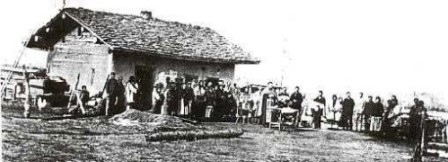
Site of the first Divine Liturgy in Canada, the next year after the event (1898)
The continuation of Theodore Nemirsky’s recollections:
Then the priest Dimitri Kamnev was sent to us by Bishop Nikolai, together with the psalmist Vladimir Alexandrov from Seattle, Washington, U.S.A. On July 16, 1897 they came to our colony quartering themselves in a tent at my brother Kost’s. This was the first mission sent to Canada because before this, no one had spoken the Holy Word in our Russian tongue. These missionaries had not yet conducted a Holy service in Canada. On my homestead… the Holy Service was conducted under the naked sky under an erected cross built of wood by Wasyl Statsko, while I had carved the message on the cross using ‘Slaviansky’ (Cyrillic) alphabet:
“IN MEMORY OF THE PASSING OF THE GALICIANS FROM THE UNIATS TO THE EASTERN ORTHODOX FAITH. 6, JULY, 1897” (Julian Calendar)
That spot I treasure, venerate as Holy. Though I have not yet placed a more worthy monument on that spot, still I continue to hope that God will inspire such a mission in the souls of good people, and that we shall raise a fitting tribute to God’s Holy Word and Orthodoxy in Canada…
At the first service of the Lord our whole people had gathered and at the time, there was a procession of about 380 souls, all united together in Orthodoxy…
We know from history that our forefathers were Orthodox. We know how Potsey and Terletsky [bishops – YP] gave us over to Rome. We know how Potsey and Terletsky signed Union with Rome…. therefore, we understand we were brought into Union by force and deceit. When we had selected for ourselves our fatherland, free Canada, then we firmly decided to have nothing to do with Rome. But, when we learned that here in Alaska, in the Aleutian Islands and in the United States there were many Orthodox and even a whole hierarchy with a Bishop, then we immediately turned there…
Now, resuming Nemirsky’s account, in 1897, after having received letters of request from newcomers to this and other regions around Edmonton, Bishop Nicholas (Ziorov) at first offered to come himself. However, the humility of the settlers was such that they understood that they could not properly receive a bishop, so they declined the offer. Instead, Bishop Nicholas sent the Priest Dmitri Kamnev and Vladimir Alexandrov from Seattle, Washington, to Alberta, and specifically to the region of Wostok.
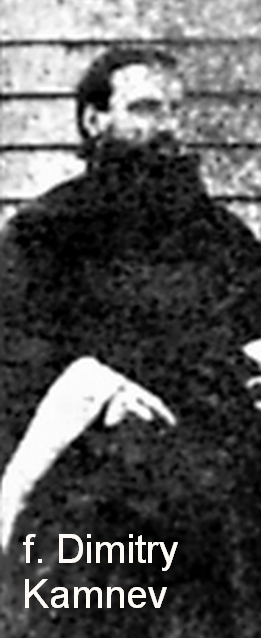 On 16 July [the exact day in July in not quite definable – YP], 1897, the first documented Divine Liturgy on Canadian soil was served by Father Dmitri and Vladimir at the farm of Fedor Nemirsky, where 380 settlers gathered.
On 16 July [the exact day in July in not quite definable – YP], 1897, the first documented Divine Liturgy on Canadian soil was served by Father Dmitri and Vladimir at the farm of Fedor Nemirsky, where 380 settlers gathered.
On 23 July, 1897, Vladimir Alexandrov filed an application for 40 acres of land for a church site and a cemetery. There was also a request for some land to construct a priest’s residence. During that year, this district became known as Wostok, after the Old Church Slavonic word “vostok”, meaning “east”.
Both during this first visit, and during the subsequent visit in the following year, (together with the already Deacon Vladimir Alexandrov) he served this community and many others. This included the frequent serving of the Divine Liturgy as Father Dmitry moved from place to place.
As a result of this missionary venture, Theodore also became a founding member of the Russo-Greek Catholic Orthodox Temple of the Holy Trinity in Stary Wostok, Alberta.
This is from Father Dmitry’s report to Bishop Nicholas when he returned from this visit:
Everywhere we were met with great joy; all without hesitation wanted to join the Holy Orthodox Church and above all, they were concerned that there was no Temple. Given their position in a strange land, the need for one was expressly felt. We comforted them that we would have a service on Saturday and Sunday, in which time they could fulfil their wish – to join the Orthodox Church. With much joy all of them agreed to come.
There was no fitting home in which to have a Liturgy and so it was decided to have it in the open air. A rise in the midst of the open prairie on the farm of Theodore Nemirsky was chosen: on the crest of the land was placed a large three-barred Cross, decorated with a wreath of wildflowers and greenery. A new table was hedged with spruce saplings along its three sides, and between these trees white cloth was draped to ensure so that the candles could remain lighted. Although at this time there is often rain, the weather remained quiet and clear as if for our purposes.
On Saturday evening after the blessing of water and the blessing of the spot for the Holy Liturgy, an All-Night Vigil was celebrated, and then there was a suitable time to talk with the people, in which the priest could speak of the purpose of our visit, that we came because of their desire, with the blessing of our Archpastor, to become one with the Holy Orthodox Church, at which time were explained the divergences of the teaching of the western Church with the Holy Orthodox Church. There were many in attendance, mainly women and children, as all the men for the great distance could not come.
Next day in the early morning the people were already in full attendance. We began with Matins, and before the dismissal, the priest again turned to the people with the words as yesterday, and repeated the differences in teaching between the Latin Church and the Orthodox Church and after which, in response to the question: ‘Do you want to become sons of the true Orthodox Church?’ came the answer as one: ‘We want to, Father, we were Orthodox in soul and the Latin way was always repugnant to us, and we renounce it!’ After Confession and the Rite of Union, the Divine Liturgy was served, during which those who had received Confession received the Holy Mysteries.
And that evening, as the people were still assembled, after Vespers was a discussion concerning church matters. The consensus was to petition His Grace to receive the newly-joined flock into his Eparchy, a place was chosen for a church and a cemetery, and a Church Construction Committee consisting of ten people was selected. Ivan Halkov was chosen as chairman with Theodore Rudyk as his assistant. Members of the committee were: Ivan Lakusta, Konstantine Nemirsky, Dmitro Balan, Ivan Tkachuk, Vasyl Strashuk, Ivan Danchuk and Ivan Borys. Theodore Nemirsky was chosen as secretary.
The 100th Anniversary, 1997
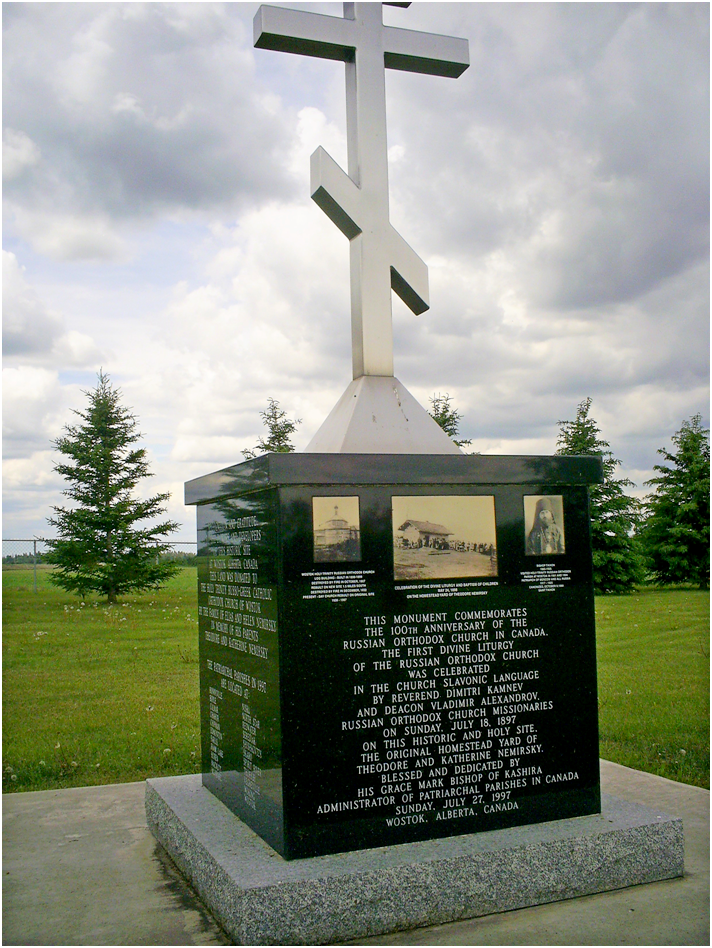 In 1997 there was a celebration of the 100th Anniversary of the First Orthodox Liturgy on the Canadian soil.
In 1997 there was a celebration of the 100th Anniversary of the First Orthodox Liturgy on the Canadian soil.
By the blessing of His Holiness Patriarch Alexiy II, the feast was headed by the Metropolitan of Minsk and Slutsk Philaret. His Eminence passed the gift from the Patriarch – the icon with the holy relics of the Saint Hierarch Tikhon – the first Orthodox Bishop, who visited the Orthodox of Alberta in 1901.
In connection with the celebration of the 100th anniversary of this event, the heirs of the Nemirskys – Ilia and Elena – presented the Patriarchal parishes with a plot of their yard measuring 165 m by 85 m. After the landscaping of the territory, a monument in the form of a Holy Table made of black granite with a stainless-steel cross was erected on it.
It was decided to annually celebrate the Liturgy and (or) a Thanksgiving Moleben in honor of the first Orthodox Liturgy in Canada and arrange a festive picnic at this place on the Sunday nearest to July 18.
Reflecting on the past 100 years since the first Orthodox Liturgy was celebrated on Canadian soil, the Administrator of the Patriarchal Parishes of that time – Bishop Mark (Petrovtsiy) (now – Metropolitan of Khust and Vynohradiv, Ukraine) called to remember with deep gratitude the first pioneers who had labored for the establishment of their Orthodox Faith in Canada.” He also said: “Today, we are grateful to the bishops, priests and Orthodox believers who laboured in the past, and to those who continue to labour in the present, that the Orthodox Faith will be preserved for our future generations. We believe, and we hope, that today’s young generation who have inherited this spiritual heritage, will preserve it and increase it, diligently, as the Faith of their fathers and their great ancestors.”
The 120th Anniversary, 2017
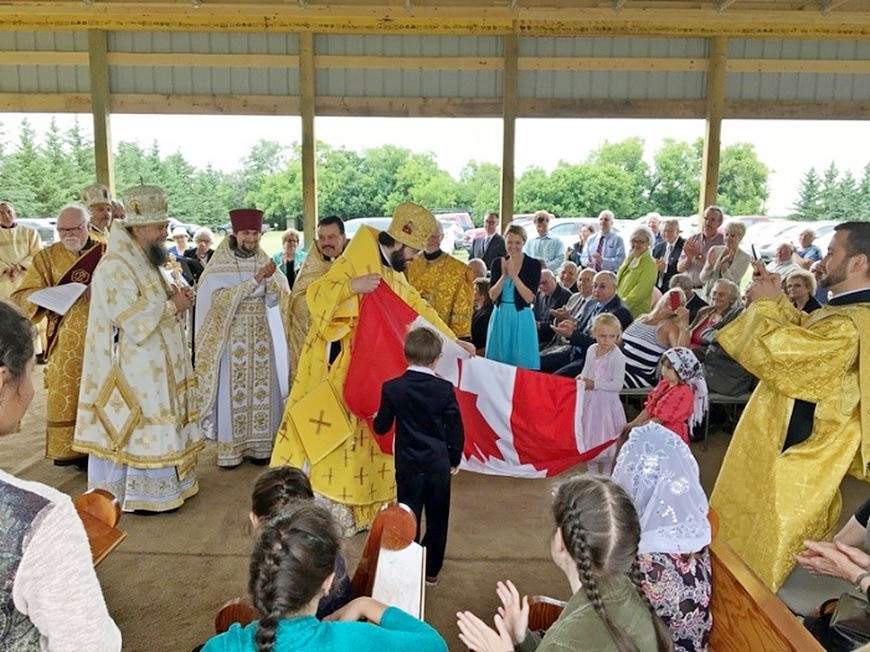 120 years since the first liturgy were celebrated very solemnly.
120 years since the first liturgy were celebrated very solemnly.
The head of the Moscow Patriarchate’s Foreign Institututes of the Russian Orthodox Church, Bishop Anthony Bogorodsky, by the blessing of His Holiness Patriarch Kirill, arrived in Canada to participate in the jubilee celebrations.
On the morning of July 23, the administrator of the Patriarchal Parishes in Canada, Bishop Job of Kashira (now – Archbishop of Shumsk, Vicar of the Ternopil Diocese, Ukraine) and Bishop Anthony (now – Metropolitan Anthony (Sevryuk), the head of the DECR, MP) celebrated the Divine Liturgy at the very place where it was first served 120 years ago.
The hierarchs were co-served by the clergy of the parishes of the Moscow Patriarchate in Canada, the Russian Orthodox Church Abroad and the Romanian Patriarchate. Liturgical hymns in Church Slavonic and English were performed by the joint choir of Orthodox V Parishes.
In his word, Bishop Anthony, summing up the significance of the event, said: “By the example of our pious predecessors who arrived in these land 120 years ago, we see that for them faith was of immeasurably greater importance than the earthly cares. Leaving their homeland forever, going “to a faraway country”, they took with them only the most necessary things – and, first of all, they brought church books, liturgical vestments, icons to Canada. Arriving at a new place, they took care of the speedy construction of temples – those that are still perfectly preserved on this land. For them, faith was a precious treasure, a living connection with God, on Whom alone they placed their trust in those difficult life circumstances they met in a foreign land.” The Archpastor wished the modern parishioners of the Patriarchal Parishes in Canada to imitate the strong faith of their ancestors and keep Holy Orthodoxy on Canadian soil.
For the great anniversary the Parish Council of Orthodox V Parishes and the rector priest Alexey Suraev constructed the steady wooden canopy covered with beautiful green metal roof over the historical and sacred site.
* * *
Today we celebrate another milestone of the great event – 125 years! May the Lord God remember all the participants of this holy history in his Heavenly Kingdom, and bless all the people who have laboured and currently work there with His peace from above and good health for many years!
Compiled by Archpriest Yevheniy Protsenko,
in 2022, based on the following materials:
“A Century of Faith”, St. Barbara’s Russian Orthodox Cathedral, Edmonton, Alberta, 1902-2002
“The History of Orthodoxy in Canada”. Report by His Grace Bishop Mark (Petrovtsiy) for 100 years of Orthodoxy in Canada
The report of His Grace Bishop Job of Kashira for the celebration of the 120th Anniversary of the first Liturgy in Canada
https://orthodoxcanada.ca/The_%E2%80%9CRussian_Mission%E2%80%9D_in_North_America#The_Russian-America_Mission
https://orthodoxcanada.ca/Theodore_and_Katherine_Nemirsky
https://orthodoxcanada.ca/Stary_Wostok_AB_Holy_Trinity_Russo_Orthodox_Church_and_Cemetery_1897
http://www.orthodox-canada.com/ru/russkiy-ofitsialnaya-hronika-prebyivaniya-episkopa-antoniya/
http://stcaterina.com/prazdnovanie-120-letiya-pravoslaviya-v-kanade/




 Save as PDF
Save as PDF